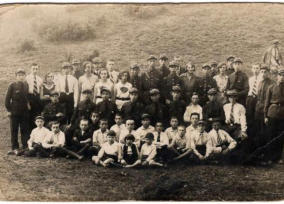




Manor House
The Manor House built by the
Mêciñski family in the early
1700’s. In the late 19th
century the manor was owned
by two local Jewish residents
J. Blankstein and M. Banasz;
who may feature in this photo.

Sources
1. The Jewish Community Authority and Social Control in Poznañ and Swarzêdz, 1650–1793 by Anna Michaowska-
Mycielska
2. There Once Was a Shtetl [Town] Dzialoszyn by Mary Rozen Translation by Gloria Berkenstat Freund from:
Tshenstokhover Yidn The Jews of Czestochowa, ed. R. Mahler, NY: United Czestochower Relief Committee and
Ladies Auxiliary, 1947. (Y).
3. Dzialoszyn: The Encyclopaedia of Jewish Communities, Poland, (Pinkas Hakehillot Polin) Volume I, pages 88-89
- published by Yad Vashem, Jerusalem. Translation by Alex P. Korn
Osjaków The Encyclopaedia of Jewish Communities in Poland, Volume I (Poland) - Pinkas Hakehillot Polin.
Translated by Morris Wirth
*Photos courtesy of Shmulik Schwartz

Działoszyn on the edge of Imperial Russia
The Imperial Russian domination of the Kingdom of Poland saw a gradual erosion of the rights of the Polish people. The direct impact on the Jewish population of the area is not recorded but as the town was within the 50 verst (33 miles) Jewish prohibition zone the communities rights would have been restricted and no Jews would have been allowed into the area to trade in the market. These regulations, originating from a Russian law introduced in 1843 during the reign of Tzar Nicholas 1st, also banned Jews from living in the area which was adjacent to the Prussian and Austrian borders. It is generally noted that Imperial Russian officials experienced great difficulty in making this law work and that led to it being redrafted in 1858 to allow ‘indigenous’ Jews to remain but preventing Jewish immigration to the banned areas. In the last decades of the nineteenth century, the economic status of the Jews of Działoszyn rapidly deteriorated. The town market no longer functioned as a springboard for trade with Silesia and beyond. Because of the decline in trade between the Russian controlled Polish Kingdom and Silesia, and because of the effect that the national crises in the textile sector had on the wool market, Działoszyn ceased to serve as a centre for the wool trade. In 1870, due to this decline, its town charter was revoked. There were no sources of income remaining for the Jews of the town except in crafts and in peddling. To add to this decline, In 1888 a third of the houses of the city went up in flames, and one hundred Jewish families were left homeless. A further disaster occured in 1900 when, after a severe winter, when the snow on the surrounding hills rapidly melted, the river burst its banks and water flooded the shtetl. Działoszyn was transformed into part of a giant river in which vehicles, livestock and even people were drawn into the flood. It was necessary to go by boat in order to return from one corner of the town to the other.2 At the beginning of the twentieth century the influence of socialistic ideologies began to spread among the youth of Działoszyn, [notwithstanding that] most of them had been educated within the spirit of the ancient traditions. These young people participatedin the revolutionary demonstrations of 1905-1907, contributed towards the goal of revolution, and, during strikes, forced the Jewish merchants to close their stores. The leadership role of the revolutionary movement for the district was in the hands of the brothers, Chaim-Yehudah and Lewek Fuks. Other active revolutionary workers were Ya'akov Solmeirski, and the bakery worker Yisrael Berkowicz, who was arrested in 1908 and exiled to Siberia. During the period between the two world wars, most of the Jewish population of Działoszyn were petty merchants and tailors who made inexpensive ready-to-wear clothing. They used to sell their own products in the markets and fairs, or travel among the villages with their wares. Especially prominent in the local Jewish community was the influence of Agudat Yisrael (the orthodox Jewish political party). Their control as well as that of other Charedim [ultra-Orthodox], was particularly strong in the Kehillah. In the twenties several modern Jewish cultural institutions were established in Działoszyn. Around 1928 the “Bildung” [i.e. Education] Society was founded with a library next to it, as well as a Drama Circle. The second library, which was called The People's Library, was established in 1930 next to the Organization of the General Zionists. A plan for the opening of an elementary Jewish school was made, but it did not come to fruition because of a lack of funding. Because of the increasing poverty of the Jewish community, the Kehillah could not find the necessary funds even to reinforce the crumbling synagogue or the Mikveh [ritual purification bath], which had already become nearly unusable. In the thirties the it obtained donations from Działoszyners living abroad for the renovations of these buildings. In January of 1937 the Jews of Działoszyn received substantial assistance from the Jewish Aid Council of the Warsaw Jewish Community. In February of the same year a Gemillut Chassadim Fund was established, which was supported by the “Joint” [i.e., the American Jewish Joint Distribution Fund] and by former Działoszyners living abroad. However, these actions did not overcome the severe poverty of significant portions of the Jews of Działoszyn.3
Click photos to enlarge
Skating
on
the
River
Warta
at
Dzia
ł
oszyn
-
(from
right
to
left)
Nusen
Szylit,
survived
the
holocaust,
Boruch
Lapides,
executed
by
German
soldiers
in
1944,
Szymon
Krakowski,
fate unknown; and unidentified friend
Dzia
ł
oszyn Jewish Tailoring class
circa 1935 *
Trading Community
Until the devastation of the 1939-1945 war, the town continued to be dominated by its market town architecture. The centre of the town consisted of a large four-sided market square with many side alleys. In each corner of the market was a well and the shtetl took its water from the four wells. In the middle of the market square (Rynek) stood the Weighing House (Vog) which at some point became the volunteer fire fighters station. The town’s chartered markets seem to have specialised mainly in wool and agricultural produce (from the surrounding farmlands). The merchants of Działoszyn were also present at the markets in the city of Wieluń and in surrounding towns and villages such as that of Osjaków
Click photos to enlarge

Click photos to enlarge

Click photos to enlarge
Dzia
ł
oszyn Betar Youth
Group
Children and Teachers at the
Dzia
ł
oszyn Elementary School circa 1932
Compiled by Martin Davis © 2010 - 17
















